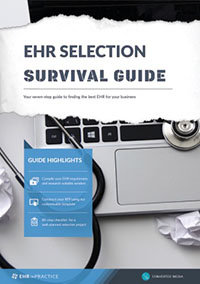How to initiate the EHR requirements gathering process
Practices change EHR systems for a number of reasons. As many organizations have moved beyond implementing their first system and are now replacing, or investing in, upgrading and optimizing existing systems; the question of what functionality and usability characteristics an EHR should have is an important consideration. A recent report from Software Path showed that 44.48% of practices purchasing EHR are looking to replace an existing system. Further research from the Medical Economics’ 2017 EHR Report found 62% of all respondents have switched EHRs during their career. While nearly half of that group say a change in employment status or practice location caused the move, the other half note a variety of deficits in their previous system that led them to look for a replacement. Given this level of dissatisfaction, one is forced to wonder what is an underlying cause of high EHR turnover and dissatisfaction.
If users are unhappy with an EHR system, they will often point their fingers at the selection team. To save yourself this unnecessary headache, it is essential to establish a clear plan for the EHR selection process. That plan should always begin with the requirements gathering phase.
The requirements gathering process, if conducted properly, provides a way for a healthcare organization to align a practice’s strategic goals and needs with EHR products being considered for selection.
Requirements gathering
A quality RFP cannot be constructed without being based on a well-thought list of EHR requirements. Creating a list of EHR requirements a practice needs to achieve their goals, known as a requirements gathering, refers to the process of collecting the needs an EHR must meet to satisfy a practice’s strategic goals.
Use this EHR selection checklist to identify your key requirements and stakeholders
The purpose of requirements gathering rests in providing a well-defined list of EHR features that best compliment a practice’s key aims. For example, a practice whose strategic goal is to reduce wait times would tailor their requirements to finding EHR products whose features could help reduce wait times such as a practice management system.
Without a well planned and executed requirements gathering process, the RFP, and by association, the selection process, will suffer and can, in some cases, result in a practice selecting an EHR that is not a good fit.
Identify key stakeholders
Identifying who will be involved in the requirements gathering process is important due to the input these individuals can provide regarding technological needs; often individuals looking at an organization from the top down may not be able to comprehend these needs.
Key stakeholders for EHR requirements analysis include the clinical staff members (who will be using the EHR system day in and day out), and the support staff which includes the reception, billing, and operations team. Also, consider the needs of your insurance and accounting team, as they will need access to process financials. Your board members, owners, and management team will have other concerns, including the cost of operations and extent of training.
Collecting information
When collecting information from key stakeholders, it is essential to focus on two main questions that should serve as guidelines for the overall requirements gathering process.
- How can an EHR contribute to your practice’s strategic goals?
- What EHR features are the best for achieving your practice’s strategic goals?
With these two broad considerations in mind, an organization should construct a list of questions that should be answered by key stakeholders in the organization that will be able to provide valuable input regarding the requirements needed.
The information gathering process can be conducted using a variety of methods including using surveys, focus groups or informal brainstorming sessions. Regardless of the information gathering strategy used, it is essential to gather data from stakeholders who are a representative sample of EHR users.
Use our free EHR customizable requirements gathering template to map out your selection project
Respondents should be allowed to provide meaningful input, based on the following questions:
- Why are we using electronic health records?
- Who will be using the new system?
- Who will require access to this system?
- How will EHR serve our medical billing operations?
- What patient population are we documenting? (i.e., pediatrics, geriatrics, outpatient vs. inpatient, hospital systems, specialty niche, etc.)
- What hardware do I have in place?
- Will this hardware be able to support a modern EHR system, or will we have to replace certain hardware components?
- What compliance and insurance documentation requirements do we have?
- Do I need an EHR that also works as a management/productivity/reporting system?
Analyzing requirements data collected
Once the data from stakeholders has been collected, the responses can be used to compile a list of needs that can be organized in any number of ways. However, at a minimum, it is important to structure a requirements list around the Institute of Medicine’s Key Capabilities of an Electronic Health Record System, or a set of 8 core care delivery functions that EHR systems should be capable of performing. The eight core functions identified by the IOM are:
- Health information and data - patients' diagnoses, allergies, lab test results, and medications, etc.
- Result management - the ability for all providers participating in the care of a patient in different settings to quickly access new and past test results.
- Order management - the ability to enter and store orders for prescriptions, tests, and other services to enhance legibility, reduce duplication, and improve the speed with which orders are executed.
- Decision support - using reminders, prompts, and alerts, computerized decision-support systems would help improve compliance with best clinical practices, ensure regular screenings and other preventive practices.
- Electronic communication and connectivity - efficient, secure, and readily accessible communication among providers and patients to improve the continuity of care, increase the timeliness of diagnoses and treatments, and reduce the frequency of adverse events.
- Patient support - tools that give patients access to their health records, provide interactive patient education, and help them carry out home-monitoring and self-testing can improve control of chronic conditions
- Administrative processes and reporting - computerized administrative tools, such as scheduling systems, to improve hospitals' and clinics' efficiency and provide more timely services to patients.
- Reporting and population health - electronic data storage that employs uniform data standards will enable healthcare organizations to respond more quickly to reporting requirements, including those that support patient safety and disease surveillance.
Using these core features as a baseline, more specialized requirements can be determined. A useful method to categorize EHR requirements relies on dividing the requirements list into functionality and usability characteristics. Functional characteristics being best described as whether or not an EHR can do a particular task, such as population health management or sophisticated data analytics. Whereas usability addresses whether or not the user can easily use those functions. Therefore, a practice which is compiling a requirements list will ask stakeholders to think regarding what needs to be done with EHR technology and what is the most efficient way it can be used.
To create this list, a methodical approach can be used that looks at input from stakeholders in practice and inputting this information into an objective scoring matrix that assigns a numerical value to each function or usability characteristic on a scale of 1 to 5 with 1 representing the lowest priority and 5 representing the highest priority. Using this data, a list of requirements can be assembled and be assigned a priority level. Using this, important strategy requirements can be separated from requirements that are viewed as discretionary.
Build a selection team
The process of building a well-balanced EHR selection team involves much work, but if you don’t take a considered approach, you may miss out on the key needs of your clinicians. Because of the broad landscape of stakeholders, you find in many practices; your EHR selection team must be assembled from all functional areas to achieve high user adoption. Do not rely on conferring with the heads of each department. Those in management may not have daily access to record keeping and patient care. It is essential that you discuss and deliberate with the direct users.
A poor requirement gathering phase means you could waste money by choosing an inadequate system and risk losing excellent clinicians because of poor operations. In the end, patient care could suffer. Therefore, proper planning is essential for a focused EHR selection process. You will know what your practice needs and you will be able to quickly eliminate insufficient systems once a comprehensive list of requirements has been generated and ranked according to their priority.
An organization that can carry out the requirements gathering phase of EHR selection in an effective manner can better equip themselves to make better decisions during the system selection process. However, a poor requirement gathering phase means you could waste money by choosing an inadequate system and risk losing excellent clinicians because of poor operations.
Original version written by Amy Vant.
Free white paper

EHR Requirements Template
Over 100 requirement and feature ideas to kickstart your EHR selection project

Featured white papers
Related articles
-

EHR requirements and key features: your complete guide
Our extended guide to EHR requirements - everything you need to know and more on the subject
-

5 key stakeholders in your EHR selection
Learn about the individuals that, when consulted early and often, can make your EHR selection pro...
-

5 important areas of EHR training during implementation
Successful EHR implementation is not possible without crucial EHR training



